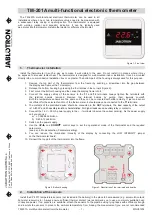
25
For each instrument, this configuration window gives some information about this particular information and
allows you to set some parameters.
The top portion of the window gives information about the specifics of the thermometer, such as:
•
COM Port number
•
Serial Number
•
Calibration date.
Description of the parameters that can be set:
•
Unit: You can select
o
C or
o
F.
•
Scan Rate: Fast (recommended for most application) or Slow.
•
Lock / Unlock Keypad (FOB100 series only): Can be selected to lock the keypad on the thermometer
unit. Warning: once locked, the keypad can only be unlocked through the use of FOB100-SOFT or
with the “l-“ serial command.
Furthermore, for each channel, you can set the following parameters:
•
On / Off: You can turn on or off the temperature for each channel.
•
Name: Up to 16 characters. You can enter a probe name here that suits your application.
•
Log: If checked, the temperature data for this channel will be logged, when data logging is active.
•
Chart: If checked, the temperature data for this channel will be displayed when one of the 4 chart
windows is open.
•
Color: This is the color of the curve that will be used when the Chart window is open.
•
Alarms, Min and Max: Allows setting alarm limits. When one of more alarms are detected, a
message is given at the bottom of the main window (must be in Acquisition mode). For a given
channel, alarms are monitored only when its corresponding “Chart”
or
“Log” checkbox is checked, in
the Configuration window pane. Alarms are monitored only when Acquisition is active.
•
Analog Outputs (FOB100 series only): Allows configuring the analog output parameters, Zero and
Span. See Section 6.3 for a complete description of these parameters.
•
Offset: Allows adding an offset to this channel. See below.
8.2.1.1
Adjusting a temperature offset
FOB100-SOFT allows you to add an offset to the temperature readings that are returned by a thermometer.
This feature is equivalent to the “f” serial command, as described in Section 6.3, although it implementation in
FOB100-SOFT is somewhat different than it is for the serial command.
An offset can be useful for the following two cases:
1- To temporarily change the reading of a probe that is believed to be in error (one-point calibration
procedure). This usually requires that a good temperature reference be available.
2- To force an offset to a reading, for example may want to monitor a temperature variation from a
given set temperature. In this case, you can simply enter the “0” value as a forced temperature
setting, and the resulting reading will give you a + or - deviation from the set temperature point.










































